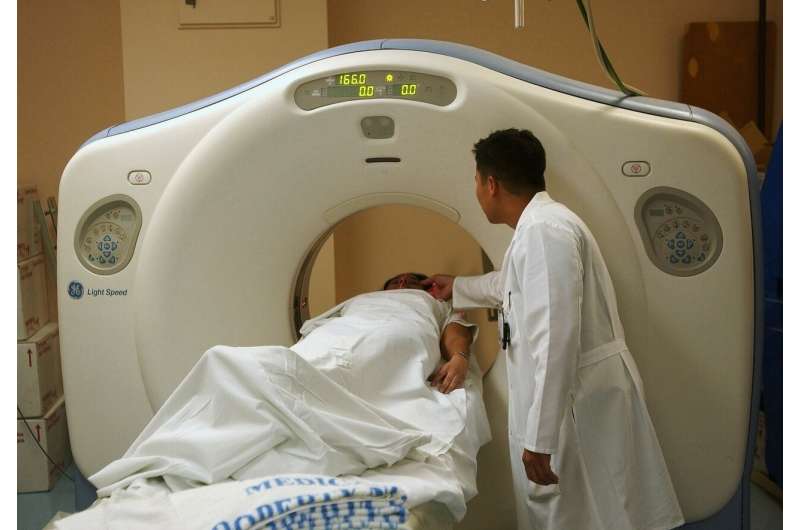 Credit: Pixabay/CC0 Public Domain
Credit: Pixabay/CC0 Public Domain
Computed tomography (CT) scans of the chest, abdomen, and spine, taken originally to detect problems such as kidney stones or growths on the lungs, can be repurposed through artificial intelligence (AI) to catch signs of bone loss, a new study shows.
NYU Langone Health radiologists who developed the AI tool with experts at Visage say their new tool will soon be ready to provide “opportunistic screening” in NYU Langone hospitals for osteoporosis. The effort will be part of a clinical trial to diagnose those with unknown low bone density, using CT scans taken for other purposes.
Published in the journal Radiology, the study showed that evidence of…
 Credit: Pixabay/CC0 Public Domain
Credit: Pixabay/CC0 Public Domain
Computed tomography (CT) scans of the chest, abdomen, and spine, taken originally to detect problems such as kidney stones or growths on the lungs, can be repurposed through artificial intelligence (AI) to catch signs of bone loss, a new study shows.
NYU Langone Health radiologists who developed the AI tool with experts at Visage say their new tool will soon be ready to provide “opportunistic screening” in NYU Langone hospitals for osteoporosis. The effort will be part of a clinical trial to diagnose those with unknown low bone density, using CT scans taken for other purposes.
Published in the journal Radiology, the study showed that evidence of weakening bones could be found when the bone mineral density recorded by CT imaging dipped below certain thresholds. These measures were calculated specifically for every major lumbar and thoracic vertebra in the body, based on age, gender, and race and ethnicity.
For the study, researchers used AI tools to analyze 538,946 CT examinations from 283,499 NYU Langone patients. The CT scans were performed using 43 machine models and all standard test protocols, representing a spectrum of CT scanning. The team’s analysis revealed trends in bone loss across a patient population diverse in age, sex, and race and ethnicity. Radiologists then verified the findings for accuracy.
In contrast to widespread belief, researchers found that young women, those under age 50, had higher bone density than men of the same age. This discrepancy decreased as women and men grew older, with steeper declines among postmenopausal women.
As a result, men over age 50 had higher bone density than older women. Bone density was highest among Black people, followed by Asian people, and lowest in White people.
“Our study offers proof that existing medical images done for other reasons can be repurposed and used to reliably identify bone loss, such as in osteoporosis,” said study senior investigator Miriam Bredella, MD, MBA. Bredella is the Bernard and Irene Schwartz Professor of Radiology, associate dean for translational science, and director of the Clinical and Translational Science Institute at the NYU Grossman School of Medicine.
Osteoporosis is estimated to affect more than 10 million Americans, mostly women over age 50, with more than 40 million other men and women showing early signs of low bone mass—much of it untreated. The danger, experts say, is that the bone-weakening disease can lead to fractures. Some of the fractures, especially in the hip, are often life-threatening.
“Our goal is to use the large quantity of imaging data that we already have on site at scale to potentially resolve the problem of underdiagnosis of osteoporosis and help people with the disease live healthier lives with stronger bones,” said study co-investigator Soterios Gyftopoulos, MD, MBA. Gyftopoulos is a professor in the Departments of Radiology and Orthopedic Surgery at the NYU Grossman School of Medicine.
Past research performed by Gyftopoulos showed that opportunistic screening could more than double the number of patients tested annually for the disease, with estimated annual savings in Medicare costs of more than $2.5 billion.
Bredella says AI tools, such as those used by NYU Langone, have the potential, if adopted widely, to change the disease’s trajectory. Many people do not know they have osteoporosis until they break a bone.
The NYU Langone research team plans to use similar scanning data sets to develop other AI-based computer programs that could potentially diagnose other diseases, including heart and blood vessel diseases, and loss of muscle mass.
The team’s earlier investigations suggest that opportunistic screening of abdominal CT scans has similar potential, revealing cardiovascular risk instead of osteoporosis.
More information: Deep Learning-Based Opportunistic CT Osteoporosis Screening and Establishment of Normative Values, Radiology (2025). DOI: 10.1148/radiol.250917
Citation: AI-based analysis of routine CT scans may also reveal weakened bones (2025, November 11) retrieved 11 November 2025 from https://medicalxpress.com/news/2025-11-ai-based-analysis-routine-ct.html
This document is subject to copyright. Apart from any fair dealing for the purpose of private study or research, no part may be reproduced without the written permission. The content is provided for information purposes only.